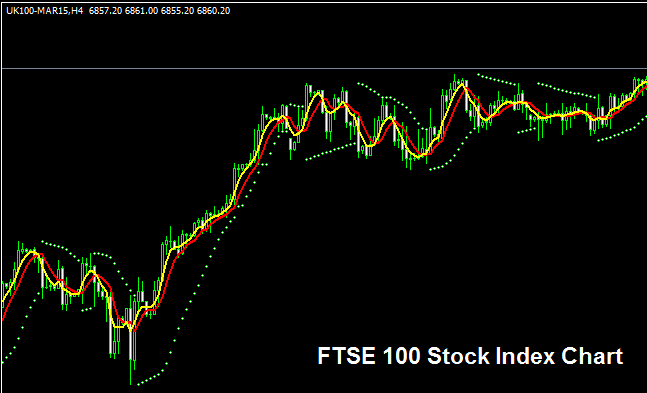FTSE100 Index
FTSE - Financial Times Bourse, the FTSE100 index represents the Indices of top 100 largest companies in UK that are displayed in London Stocks Market. The calculation of this stock index incorporates stocks which are determined quarterly. These stocks included in the FTSE100 Index represent 80% of total market value of London Bourse displayed companies.
Because the FTSE100 Stock Indices tracks 100 companies the index will be more volatile as compared to an index such as Germany DAX30 which only tracks 30 companies.

The FTSE100 Trading Chart
The FTSE100 trading chart is shown and illustrated above. On the example above the index is named UK 100CASH. As a trader you want to find an online broker that provides FTSE100 trading chart so that you can begin to trade it. The example above is of FTSE100 Stock Indices on MT4 Forex and Stock Indices Trading Software.
Other Information about FTSE100 Index
Official Symbol - UKX:IND
The 100 component stocks that makes up FTSE100 Index are selected from the top UK companies. The FTSE100 share index is closely followed as an indicator of the prosperity of UK businesses. The constituents that make up this stock index are revised quarterly. The calculation of this stock index is a simple formula based on market capitalization.
Strategy for Trading FTSE100 Index
The FTSE100 Index shows relative movement of top 100 stocks in UK. In general the share value of top 100 companies will keep heading upward, therefore this stock index will also over time keep heading upward. Should a company not meet the required growth targets, the company will be removed from the index and replaced with another company that has better growth prospects.
As a trader wanting to trade this Stock Index, the general market direction at any given time will be more bullish than bearish. This is because as long as the 100 companies being tracked are doing good business, then their share value will keep going up, and therefore this stock index will also keep heading in an upwards trend.
As a trader you want to be biased & keep buying as the index moves upward. When UK economy is doing well (most of the times it is doing well) this upwards trend is more likely to be ruling. A good strategy would be to buy the dips.
During Economic Slow-Down & Recession
During economic slow-down & recession times, companies begin to report lower profits & lower growth prospect. It is because to this reason that traders begin to sell stocks of companiesthat are reporting lower profits & therefore Indices tracking these specified stocks will also begin to move downward.
Therefore, during these times trends are likely to be moving downward & you as a trader should also adjust your strategy accordingly to suit the prevailing downwards trends of the stock index that you are trading.
Contracts & Specifications
Margin Requirement Per Lot - £ 70
Value per Pips - £ 0.1
Note: Even though general trend is generally upwards, as a trader you have to consider & factor in daily market volatility, on some of the days the Indices might move in a range or even retrace and pull-back, the Indices market retracement move might also be a significant one at times & therefore as a trader you need to time your trade entry precisely using this trade strategy: trading strategy and at same time use proper money management guidelines just in case there is more unexpected volatility in the market trend. About money management methods in stock indices trading topics: What is Stock Index money management & Indices money management methods.


